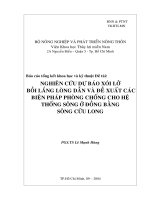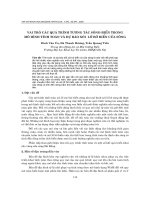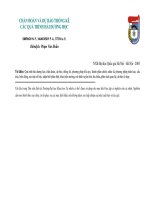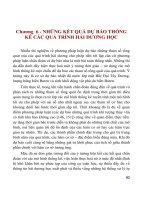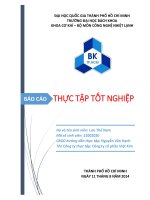Dự báo xói lở chân công trình
Bạn đang xem bản rút gọn của tài liệu. Xem và tải ngay bản đầy đủ của tài liệu tại đây (1.57 MB, 99 trang )
Estimating Scour
CIVE 510
October 21st , 2008
1
Causes of
Scour
2
Site Stability
3
Mass Failure
• Downward movement of large and intact
masses of soil and rock
• Occurs when weight on slope exceeds the
shear strength of bank material
• Typically a result of water saturating a
slide-prone slope
– Rapid draw down
– Flood stage manipulation
– Tidal effects
– Seepage
4
Mass Failure
• Rotational Slide
– Concave failure plane, typically on slopes
ranging from 20-40 degrees
5
Mass Failure
• Translational Slide
– Shallower slide, typically along well-defined
plane
6
Site Stability
7
Toe Erosion
• Occurs when particles are removed
from the bed/bank whereby
undermining the channel toe
• Results in gravity collapse or sliding
of layers
• Typically a result of:
– Reduced vegetative bank structure
– Smoothed channels, i.e., roughness
removed
– Flow through a bend
8
Toe Erosion
9
Toe Erosion
10
Site Stability
11
Avulsion and Chute Cutoffs
• Abrupt change in channel alignment
resulting in a new channel within the
floodplain
• Typically caused by:
– Concentrated overland flow
– Headcutting and/or scouring within
floodplain
– Manmade disturbances
• Chute cutoff – smaller scale than
avulsion
12
Avulsion and Chute Cutoffs
13
Site Stability
14
Subsurface Entrainment
• Piping – occurs when subsurface flow
transports soil particles resulting in
the development of a tunnel.
• Tunnels reduce soil cohesion causing
slippage and ultimately streambank
erosion.
• Typically caused by:
– Groundwater seepage
– Water level changes
15
Subsurface Entrainment
16
Groundwater
table
Normal water level
Seepage
flow
Normal (baseflow) conditions
Flood water level
Seepage
flow
During flood peak
Area of high seepage
gradients and uplift pressure
Seepage
flow
Normal water level
After flood recession
Site Stability
20
Scour
“Erosion at a specific location that is
greater than erosion found at other
nearby locations of the stream bed or
bank.”
Simons and Sentruk (1992)
21
Scour
• Scour depths needed for:
– Revetment design
– Drop structures
– Highway structures
– Foundation design
– Anchoring systems
– Habitat enhancement
22
Scour Equations
• All empirical relationships
• Specific to scour type
• Designed for and with sand-bed systems
• May distinguish between live-bed and
clear-water conditions
• Modifications for gravel-bed systems
23
Calculating Scour
• Identify type(s) of expected scour
• Calculate depth for each type
• Account for cumulative effect
• Compare to any know conditions
24
5 Types of Scour
• Bend scour
• Constriction scour
• Drop/weir scour
• Jet scour
• Local scour
25
